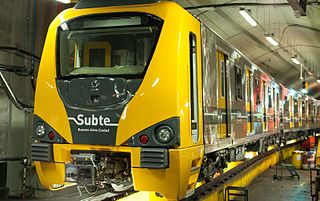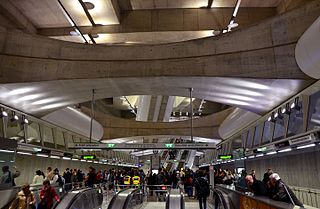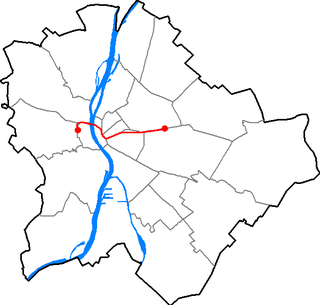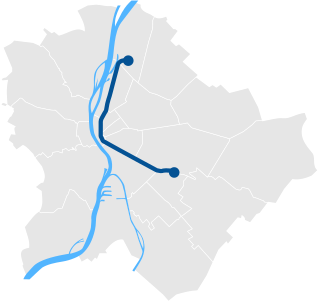| Line 4 | |||
|---|---|---|---|
 | |||
A train arrives at Szent Gellért tér. | |||
| Overview | |||
| Type | Rapid transit | ||
| System | Budapest Metro | ||
| Status | Operational | ||
| Termini | Kelenföld vasútállomás Keleti pályaudvar | ||
| Stations | 10 | ||
| Line number | Line 4 ("Green metro") | ||
| Website | www.metro4.hu | ||
| Operation | |||
| Opened | March 28, 2014 | ||
| Operator(s) | BKV | ||
| Technical | |||
| Line length | 7.4 km [1] | ||
| Track gauge | 1,435 mm (4 ft 8 1⁄2 in) | ||
| Electrification | 750 V DC | ||
| Operating speed | 80 km/h [2] | ||
| |||
Line 4 (officially: South Buda–Rákospalota (DBR) Line, Metro 4 or M4, and unofficially: Green Line), is the fourth line of the Budapest Metro. It opened on 28 March 2014. [3]

The Budapest Metro is the rapid transit system in the Hungarian capital Budapest. It is the oldest electrified underground railway system on the European continent, and the third-oldest electrically operated underground railway in the world, predated by the 1890 City & South London Railway and the Liverpool Overhead Railway in 1893-96. Its iconic Line 1 was completed in 1896.
Contents
- History
- Controversies
- Delays
- Costs
- Route
- Unfunded extensions
- Operation
- Stations and connections
- External links
- References
The first section, 7.4 km in length and consisting of ten stations, connects the southwestern Kelenföld vasútállomás located in Buda, and the eastern Keleti pályaudvar in Pest, under the River Danube. While three additional sections — one an eastern extension to Bosnyák tér, the second west to Virágpiac, and a third further east to Újpalota — have been planned, these remain unfunded by the Budapest city government and the European Union. [4]

Pest is the eastern, mostly flat part of Budapest, Hungary, comprising about two thirds of the city's territory. It is separated from Buda and Óbuda, the western parts of Budapest, by the Danube River. Among its most notable sights are the Inner City, the Hungarian Parliament, Heroes' Square and Andrássy Avenue. In colloquial Hungarian, "Pest" is often used for the whole capital of Budapest. The three parts of Budapest united in 1873.

Újpalota is a panel housing estate in the 15th district of Budapest, Hungary.
Before Line 4 was built, only Line 2 served the Buda side of the river. Daily ridership has been estimated at 421,000. The line operates using fully automated Alstom Metropolis train sets, which are also used on Line 2. [5]

The Alstom Metropolis is a family of electric multiple units built by Alstom designed for high capacity rapid transit or metro rail infrastructure systems. The trains are in service in 22 major cities around the world, representing more than 3000 cars, including Singapore, Shanghai, Budapest, Warsaw, Nanjing, Buenos Aires, São Paulo, Lima, Santiago, Chile, Barcelona, Istanbul, Santo Domingo, Chennai and Kochi. Amsterdam ordered 23 Metropolis trains; the first one came into operation June 2013. Xiamen also ordered some Metropolis trainsets for the Xiamen Metro. Trains can be run in configurations of 2 to 10 cars using manned or unmanned operations.
In Hungary the construction of the line has been widely criticised for its route perceived as outdated, although the general city-structure and population density remained unchanged. The line has been noted for its high costs and inordinate delays — 17 in total — during construction. [6] [7]























